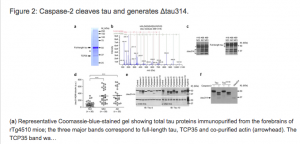
Abstract
In Alzheimer’s disease (AD) and other tauopathies, the tau protein forms fibrils, which are believed to be neurotoxic. However, fibrillar tau has been dissociated from neuron death and network dysfunction, suggesting the involvement of nonfibrillar species. Here we describe a novel pathological process in which caspase-2 cleavage of tau at Asp314 impairs cognitive and synaptic function in animal and cellular models of tauopathies by promoting the missorting of tau to dendritic spines. The truncation product, Δtau314, resists fibrillation and is present at higher levels in brains from cognitively impaired mice and humans with AD. The expression of tau mutants that resisted caspase-2 cleavage prevented tau from infiltrating spines, dislocating glutamate receptors and impairing synaptic function in cultured neurons, and it prevented memory deficits and neurodegeneration in mice. Decreasing the levels of caspase-2 restored long-term memory in mice that had existing deficits. Our results suggest an overall treatment strategy for re-establishing synaptic function and restoring memory in patients with AD by preventing tau from accumulating in dendritic spines.
Fig. 2
Fig. 3
Fig. 4
Fig. 5
Fig. 6
Source:












